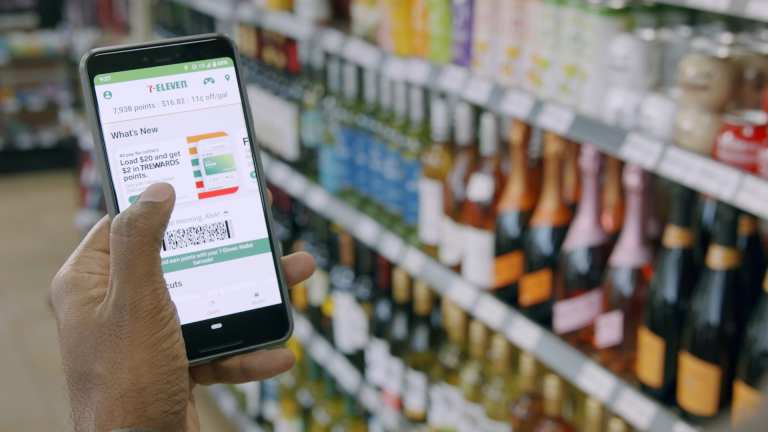
The digital-first economy was the story of 2020, but for many successful companies it wasn’t a complete surprise. It was an acceleration. It was a business evolution that they were prepared for regardless of the verticals they operate in. One of the companies that fits into that category is 7-Eleven. The pandemic had an effect on how it served the customer, but it didn’t require a complete rewrite of the company’s digital roadmap.
As 7-Eleven Senior Vice President and Head of Digital Raghu Mahadevan told Karen Webster in a recent conversation, the convenience store chain had been moving toward digitizing the business for the last several years. Relatively recent additions to the firm’s digital lineup had all been in the works, including the rollout of its loyalty program, mobile wallet, delivery program and self-checkout offerings.
COVID-19, he said, has powerfully accelerated the digital shift and the blurring of old boundaries that once separated convenience stores from grocery stores and quick-service restaurants (QSRs). And with 9,300 locations within minutes of 50 percent of the U.S. population and an increasingly robust stable of digital services, he said, 7-Eleven is ready to take on a year that Mahadevan believes will ultimately be a wilder ride that 2020 was.
“The thing that 7-Eleven has done right is to continue to redefine convenience,” he said. “We’re trying to look out for what’s next, where the consumer is heading and how can we make it a really delightful shopping experience for them. Ultimately it goes back to the fact that customers want convenience. And if you make it convenient for the customer, and offer them value and safety front and center, you will be the company that best serves that customer.”
It is not about building a single digital journey for every customer, he said, but putting the digital tools in place so that the customer can be the captain of their own commerce ship and chart their shopping journey to meet the specific contours of their own needs.
The Many Shifts Of 2020
The customer 7-Eleven saw this year was different from the customer the company saw pre-pandemic. The timing of shopping has shifted as far fewer people are currently commuting to work. That big spike of customers they saw every morning, Mahadevan notes, has ebbed. But those customers haven’t stopped coming in. What they’ve done is started spreading their business out over the course of the day.
They are also, he said, using 7-Eleven somewhat differently. Consumers are tapping them more often for things like grocery goods and pre-prepared meals because they don’t want to expose themselves to a large group of people in a big box store or grocery store when all they need is one or two top-off items like milk and bread. They are increasingly enthused, on a related note, about using 7NOW, the firm’s delivery offering, to have those quick grocery top-offs delivered right to their front door.
They’ve also, to a degree, he said, changed their relationship to payments — particularly contactless. Some consumers are confident enough in wearing their masks and touching items as they go. But, he said, that’s not every consumer, as a good many have really gravitated toward those contactless checkout options.
“We’re hearing from our franchisees that this is really resonating with the customer because they come in, they put the product on the counter, they pick up their phone and use the wallet,” Mahadevan said. “It’s a seamless experience and, net, I think the ecosystem is working pretty well. And a big thing which is actually helping us here is the ability for customers to load cash into the mobile wallet for use.”
That cash inclusion, he said, is critical, as there are roughly tens of millions of Americans who are unbanked, underbanked or largely cashbound. Designing digital for 7-Eleven meant designing it with an eye toward a product that works across segments.
“Since the launch of our wallet, we have seen a lot of customers loading cash on. Now they have access to our entire ecosystem, including our loyalty program,” Mahadevan said.
And that total accessibility, he said, is becoming increasingly relevant as the competitive landscape that the C-Store exists in is becoming a very different place.
Blurred Boundaries And A Very Busy 2021
There were once defined lines between categories like convenience store, grocery store and QSR restaurant — at this point, those lines are so blurred as to be almost non-existent. Players like DoorDash are stepping into the convenience space to throw their hats in as competitors with their own digital stores.
It is a unique situation that portends a lot of shifting over the next year. And yet, he said, with 40 million rewards members now signed on, 7-Eleven is feeling confident as those members are already starting to double up on their visits and purchases. Also, 7-Eleven has the advantage of proximity to their customers, which means it has the opportunity to be the most convenient and fastest option when it comes to putting the product in the consumer’s hands.
But the playing field, he said, will be full and incredibly busy — and as far as shifts go, the industry as a whole is really only just getting started.
“The year 2021 looks even more exciting and fast-paced than 2020 has been,” Mahadevan said. “Our goal now is to ensure that we thread all the different pieces together within our digital ecosystem.”